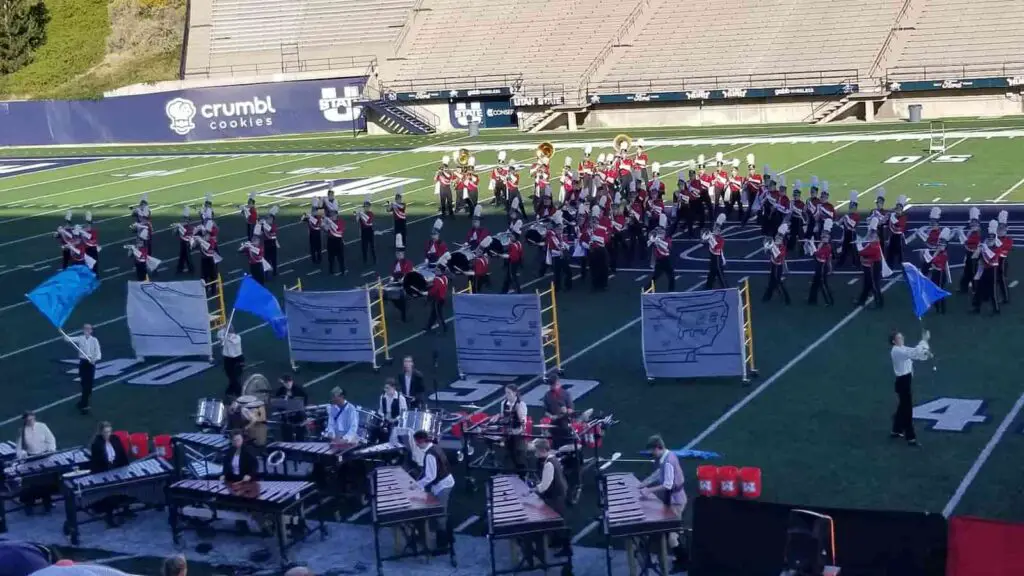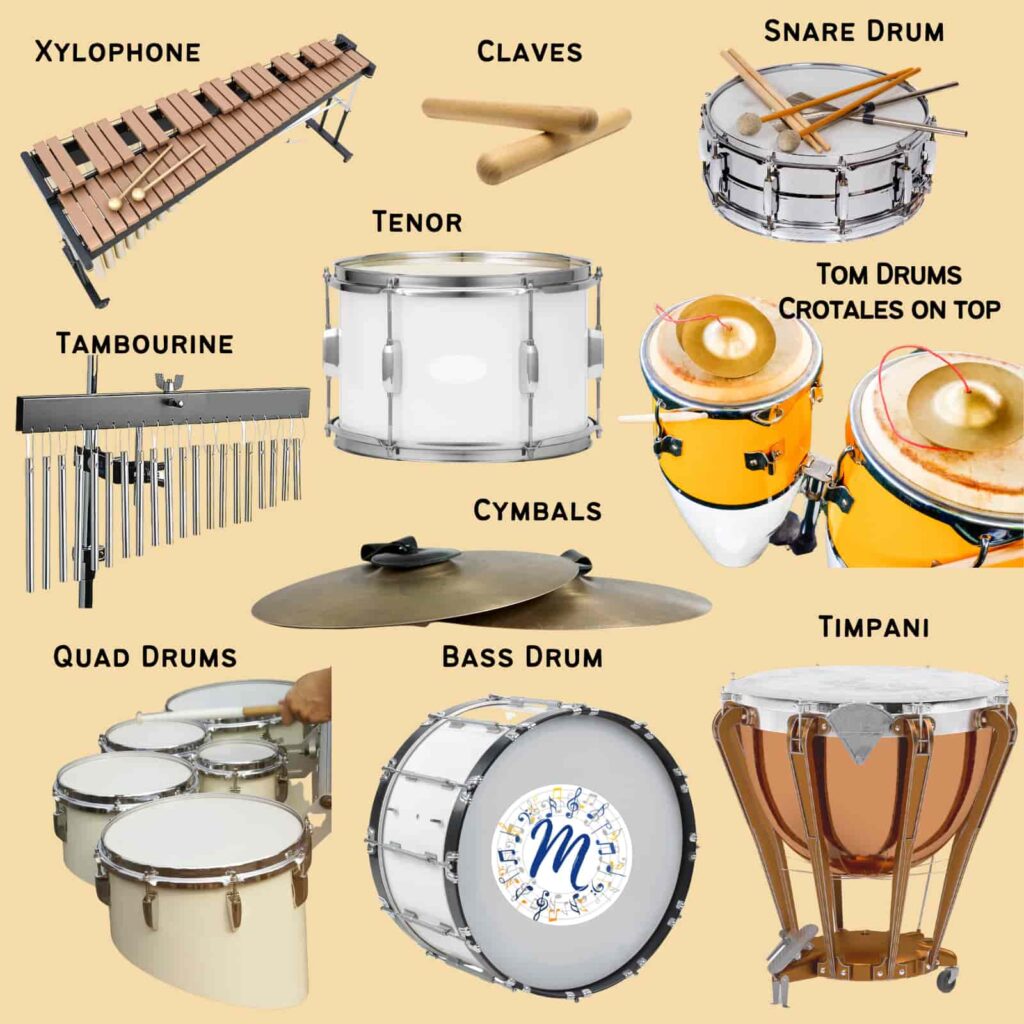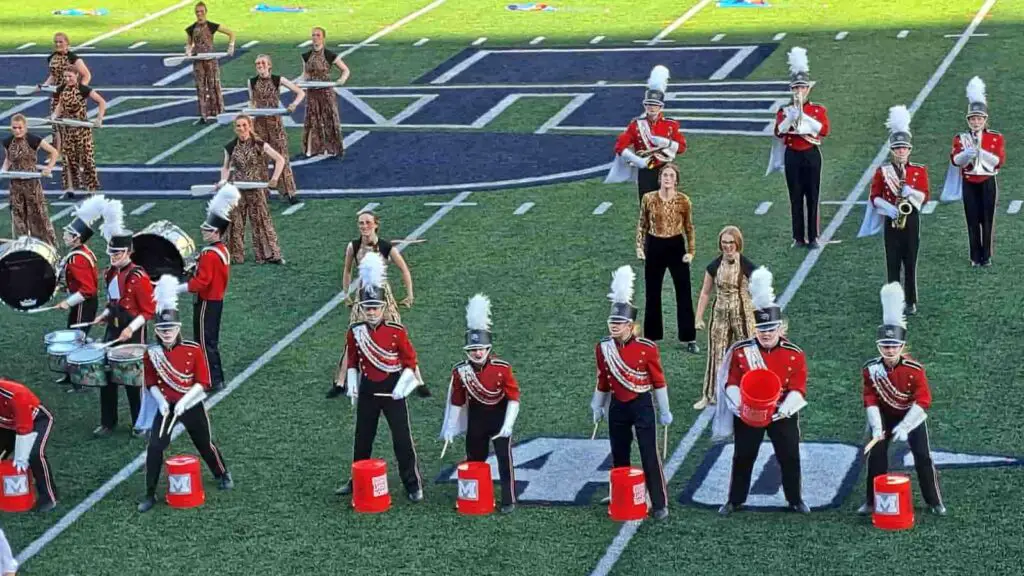One of my absolute favorite sounds at the start of a halftime show, or at the beginning of a marching band competition is the distinctly familiar tap tap tap of the Drumline.
The percussion line in marching band has always been the glue that helps keep the marching band together with a steady rhythm and baseline.
The marching band percussion line has a historically significant beginning and a long practical evolution. What started with one drum, signaling military troop movements, has grown into a large technical ensemble with multiple types of drums and other percussion instruments.

The ensemble of instruments that now make up the marching band percussion line come from all over the world and all throughout history.
🎵 Note: These instruments are used to create a variety of technically rhythmic and melodic pieces and to support the rest of the marching band in ways that go beyond simply providing the downbeat.
Keep reading to discover how the marching band percussion line came to be, what the various instruments are, and find answers to your frequently asked questions about marching band percussion.
What is marching band percussion?
Marching band Percussion is the section in the marching band that contains the marching drums (often called the drumline) and a sidelined group of non-marching Percussion instruments known as the pit.
This includes the entire group of percussion instruments. Sometimes it seems like the drumline gets all the glory, but in reality, it’s the entire team of percussion members that helps to make the band great!
The marching Percussion section has its beginnings with the military. Drums were used to call soldiers to arms, get them into formation, and direct their movements.
Today’s marching band began to form over time as instruments were added to military units.
Here is a list of many of the percussion instruments in a marching band (Not all listed will be in every marching band)
- Snare Drum
- Bass Drum
- Tenor / Quad Drums
- Cymbals
- Concert Toms
- Xylophone
- Glockenspiel / Bell Lyre
- Marimba
- Vibraphone
- Chimes
- Timpani
- Keyboard
- Other instruments that add uniqueness and flavor to the specific show (electric guitar, bongo drums)

Now with more melodic and rhythmic instruments, marching bands are used for parades and programs. As the overall marching band grew over time, so has the marching band’s Percussion section.
🎵 Note: The percussion that is used in a parade for marching band will be different than the percussion that is used in a competition or halftime show.
Marching Percussion Evolution
As with most things in life things change. The percussion section in the marching band has changed over the last century and we love where it’s headed!
1300s – Marching drums were used more with armies to signal and direct troops.
1700s – Additional instruments like trumpets, fifes, and larger drums were added to aid morale and to make days of marching more interesting by adding songs and more intricate rhythms and cadences with a new variety of instruments.
1800 & 1900s – Marching percussion has to be mobile and secured to the player as they move. Ropes and pieces of cloth were first used to secure instruments to drummers during marching.
2000s – Those mounting systems are now replaced with Hi-Tech, lightweight materials that make the drums easier to march with and play.
The role of today’s Marching and Frontline Ensemble Percussion has evolved from military movement to:
- Rhythm-keeping.
- Adding sound effects.
- Creating excitement musically and visually in settings from Middle School Marching Bands to Professional Drum Corps.
The Tabor
One of the original marching drums was called the ‘Tabor.’ The Tabor was used in the 1300s and is played by hitting the drum head with a stick while suspending the drum with a rope held in the opposite hand. By the 1400s Ottoman and Swiss armies began using the Tabor for troop movements.
Later versions of the Tabor had a top head and a bottom head. The bottom head had a string to change the sound.

This innovation would eventually evolve into today’s snare drum which has a thinner bottom head and multiple strings or wires stretched across the head to produce a snapping or loud crack when the top head is hit pushing air to vibrate the bottom head.
🎵 Note: The Tabor is the ancient ancestor of the modern-day snare drum.
What instruments are in marching percussion?
The instruments in marching percussion include mounted versions of the snare drum, bass drum, quad/quint/squint concert toms, bell lyra, and hand crash cymbals.
Marching Snare Drum
(Click link above for our article about marching snare drums!)
The marching snare drum differs from the concert snare drum in size and sound. Marching snare drums have a deeper shell and are built with lightweight construction in mind since the instrument will be carried rather than set on a stand.
That doesn’t mean they’re wimpy. In fact, the marching snare drum is built to talk a literal beating. That’s because the marching snare drummer has to project their sound usually outdoors often in a stadium or parade environment.
🎵 Note: Marching snare drum sticks are larger in diameter than concert snare drum sticks or sticks used for drum sets.
Marching Bass Drum
(Click link above for our article about marching snare drums!)
The marching bass drum is unique from the concert bass drum both in size and sound. In a marching band, you may have one bass drum or multiple bass drums. Marching bass drums come in sizes ranging from 14 to 32 inches in head diameter.
The smaller drum can have a shorter, higher-pitched sound than the larger ones. Using multiple-sized bass drums can create intricate rhythms with melodic tones.
Quad/Quint/Squint Concert Toms
Quads (4 drums), quints (5 drums), and squints (6 drums, also known as sextets) are also called tenor drums or toms.
Tenor drum sets can have a range of sizes including 6, 8, 10, 12, and 14. The smallest drums can be doubled in a set and used to create a “shot” drum which produces a loud “crack” used for heavy accents and loud effects.
🎵 Note: Carrying so many drums at one time requires a special harness and a percussionist with a strong back.
Marching drum corps and many college marching bands may have as many as 5 percussionists marching tenors while junior and senior high marching bands may only require 1 or 2 sets of tenors for their performances.
Hand Crash Cymbals
Hand crash cymbals used in marching percussion differ from those used in concert bands or orchestras. Some marching bands will employ multiple sets of cymbals differing in size to create a variety of sounds.
Concert band, marching band, and drum corps cymbals tend to have medium, medium heavy, and heavy weights, respectively, and produce full, brighter, and penetrating sounds with longer decay times. Whereas orchestral cymbals tend to be lightweight, thin, and have a short decay time.
Marching cymbals also come in different colors if the desire is to have a certain look or color scheme on the marching field.
The technique for holding and playing the hand crash cymbals in marching band is also different. The grip used to play cymbals in the marching band puts the hands through the straps and then the hands stay flat on each cymbal. This grip was named the “Garfield Grip” after the drum and bugle corps that made it popular, The Garfield Cadets.
What instruments are not in marching percussion?
These instruments are still considered part of the percussion section, but they DO NOT march. The instruments are too heavy to carry.
The percussion instruments not in marching percussion are called the pit or the front ensemble. These instruments are positioned on the sidelines because they are too large to march. Auxiliary percussion instruments are also included in the pit.
Typical Pit Instruments:
- Timpani
- Cymbals
- Glockenspiel/bells
- Xylophone
- Marimba
- Vibraphone
- Chimes
- Crotales
🎵 Note: The front ensemble of percussionists are called the pit as a reference to an orchestra “pit” in musical theatre where the musicians are typically in a pit in front of or under the theatre stage.
The instruments used in the pit are larger instruments difficult to move or march with. Many marching band pits will have one or all of the mallet instruments and sometimes duplicates to create unity and volume of sound.
Some marching band pits will have a complement of ethnic drums, shakers, and even stranger-looking tools to create various moods and sound effects.
🎵 Note: Pianos are generally not used in marching bands, but keyboards have been increasingly used as an instrument in the pit. The keyboards can add a lot of different types of sound and sound effects to the music.
FAQ
Why is percussion called battery?
Percussion is called a battery as a comparison to a “battery of cannons.” This coined phrase in English comes from the time when drums were used to signal troop movements and commands.
🎵 Note: The word “Percussion” also originates in military jargon. The percussion cap is a part of the weapons used in the early 1800s which replaced the flintlock rifle.
In military terms, a coordinated artillery group is called a battery or in French, a battre. The coordination of drums was reminiscent of that of cannons or rifle fire, so the terms were adopted by military personnel, and the description has stuck to this day. To further support the analogy, in French, battre also means “to hit.”
What are 4 drums called in marching band?
Quads are the name of the 4 drums in marching band. These drums are single-headed toms of differing sizes and are sometimes called tenor drums or toms.
Quad toms were first used in marching band by The Boston Crusaders Drum and Bugle Corps during the end of the 1960s. Before that time some marching bands would use a couple or a trio of medium-sized drums that sounded like timpani and so they were referred to as timp-toms.
Marching Band Percussion Unique Ideas
There are a lot of things that the percussion section can do to add uniqueness to the show. This high school band gets points for creativity when they added playing on buckets as part of their field show!

We hope this article has been helpful and informative for you in your musical journey. Please let us know if there is anything that we could add or change to make this article a better resource for our readers.
Please e-mail us at: [email protected] to let us know how we are doing!
Disclaimer: This post may contain affiliate links. We only recommend high-quality products that are used and recommended by real musicians. If you use these links to buy something we earn a small commission.
